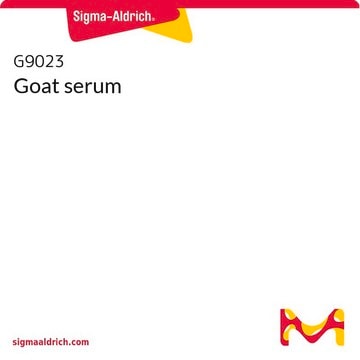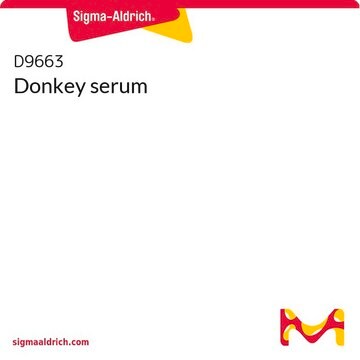Using P5282 with cells fixed in paraformaldehyde instead of methanol-free formaldehyde was attempted, but the results were not satisfactory with regular formaldehyde. A specific protocol for the reconstitution of Phalloidin P5282-.1MG in the case of tissues fixed in paraformaldehyde and included in O.C.T medium is not available. However, it is suggested to find relevant information in the literature, such as in this article, https://www.oncotarget.com/article/25259/ DOI:[10.18632/oncotarget.25259].
P5282
Phalloidin Peptide
≥90% (HPLC), solid, FITC labeled
Sinónimos:
Phalloidin-FITC
Seleccione un Tamaño
510,00 €
Seleccione un Tamaño
About This Item
510,00 €
Productos recomendados
Nombre del producto
Phalloidin, Fluorescein Isothiocyanate Labeled, sequence Amanita phalloides(synthetic: peptide sequence)
origen biológico
sequence from Amanita phalloides (synthetic: peptide sequence)
Nivel de calidad
Formulario
solid
fluorescencia
λex 495 nm; λem 520 nm(lit.)
temp. de almacenamiento
−20°C
Descripción general
Aplicación
Acciones bioquímicas o fisiológicas
Palabra de señalización
Danger
Frases de peligro
Consejos de prudencia
Clasificaciones de peligro
Acute Tox. 2 Dermal - Acute Tox. 2 Inhalation - Acute Tox. 2 Oral
Código de clase de almacenamiento
6.1A - Combustible acute toxic Cat. 1 and 2 / very toxic hazardous materials
Clase de riesgo para el agua (WGK)
WGK 3
Punto de inflamabilidad (°F)
Not applicable
Punto de inflamabilidad (°C)
Not applicable
Elija entre una de las versiones más recientes:
Certificados de análisis (COA)
¿No ve la versión correcta?
Si necesita una versión concreta, puede buscar un certificado específico por el número de lote.
¿Ya tiene este producto?
Encuentre la documentación para los productos que ha comprado recientemente en la Biblioteca de documentos.
Los clientes también vieron
Artículos
In the midst of beeping lab timers, presentations and grant deadlines, it is easy to take for granted the quality of lab reagents.
Contenido relacionado
Three-dimensional (3D) printing of biological tissue is rapidly becoming an integral part of tissue engineering.
-
Is it possible to use P5282 with cells fixed in paraformaldehyde instead of methanol-free formaldehyde?
Is it possible to use P5282 with cells fixed in paraformaldehyde instead of methanol-free formaldehyde?
1 respuesta-
¿Le ha resultado útil?
-
-
How do I prepare stock solutions of Product P5282, Phalloidin, Fluorescein Isothiocyanate Labeled?
1 respuesta-
Stock solutions of phalloidin conjugates have been made in methanol or DMSO at 0.1 to 5 mg/mL. Make final dilutions in aqueous physiological buffers for a staining range from 0.1 μM to 100 μM with corresponding incubation times of 15 minutes to 72 hours.
¿Le ha resultado útil?
-
-
What is the Department of Transportation shipping information for this product?
1 respuesta-
Transportation information can be found in Section 14 of the product's (M)SDS.To access the shipping information for this material, use the link on the product detail page for the product.
¿Le ha resultado útil?
-
-
How do I store Product P5282, Phalloidin, Fluorescein Isothiocyanate Labeled?
1 respuesta-
The product should be stored at a powder in the freezer at -20°C.
¿Le ha resultado útil?
-
-
How do I dissolve Product P5282, Phalloidin, Fluorescein Isothiocyanate Labeled?
1 respuesta-
This product is soluble in methanol, ethanol, butanol and pyridine. It is soluble in cold water at a concentration of 5 mg/mL; it is much more soluble in hot water. See: The chemicals encyclopedia published by the Royal Society of Chemistry, 12th ed., entry# 7336 (1996). Solutions should be prepared fresh, and protected from light whenever possible.
¿Le ha resultado útil?
-
-
How do I stain cells with Product P5282, Phalloidin, Fluorescein Isothiocyanate Labeled?
1 respuesta-
A typical application for staining cells can be found in the product information sheet (under Documents, above).
¿Le ha resultado útil?
-
-
What are the excitation and emission wavelengths used for fluorescent detection of Product P5282, Phalloidin, Fluorescein Isothiocyanate Labeled?
1 respuesta-
Excitation wavelengths of 540-545 nm and emission wavelengths of 570-573 nm can be used. See: Faulstich, H., J. Muscle Res. Cell Motility, 9, 370 (1988), and Waggoner, A. et al., Methods in Cell Biology, 30, 449 (1989).
¿Le ha resultado útil?
-
Filtros activos
Nuestro equipo de científicos tiene experiencia en todas las áreas de investigación: Ciencias de la vida, Ciencia de los materiales, Síntesis química, Cromatografía, Analítica y muchas otras.
Póngase en contacto con el Servicio técnico









